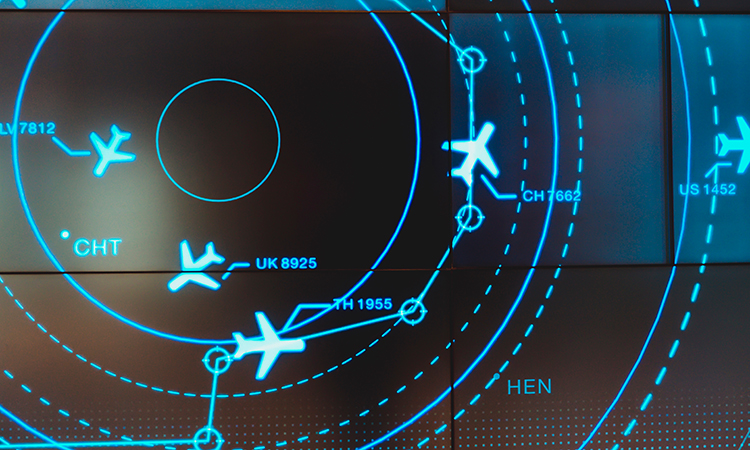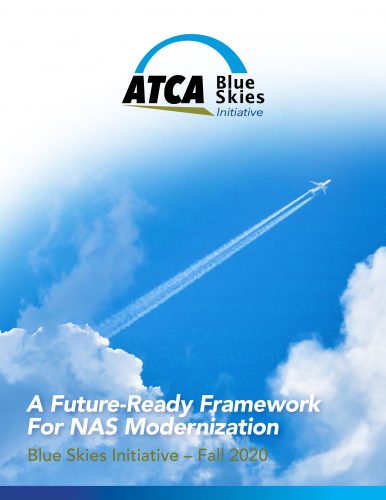Shaping air traffic management for the future National Aerospace System
- Like
- Digg
- Del
- Tumblr
- VKontakte
- Buffer
- Love This
- Odnoklassniki
- Meneame
- Blogger
- Amazon
- Yahoo Mail
- Gmail
- AOL
- Newsvine
- HackerNews
- Evernote
- MySpace
- Mail.ru
- Viadeo
- Line
- Comments
- Yummly
- SMS
- Viber
- Telegram
- Subscribe
- Skype
- Facebook Messenger
- Kakao
- LiveJournal
- Yammer
- Edgar
- Fintel
- Mix
- Instapaper
- Copy Link
Posted: 18 May 2021 | Peter F. Dumont | No comments yet
Peter F. Dumont, President and CEO of the Air Traffic Control Association (ATCA), discusses the changes to the National Aerospace System and the role of the air traffic controller that are already taking place in the American aviation sector.


Many have said it and will continue to say it: 2020 was an unprecedented year for aviation, the air traffic management (ATM) community and the world. The pandemic has impacted every facet of aviation, disrupting operations and the daily lives of the hundreds of thousands of airport workers and air traffic controllers who put their health on the line to keep the travelling public safe and essential cargo moving. Air traffic controllers cannot work from home, so ensuring their safety while on the job has been critical, yet it continues to remain a challenge across the United States (U.S.) and internationally. It was in the news almost daily that an air traffic control facility had shut down for cleaning due to a controller testing positive for COVID-19. The Federal Aviation Administration (FAA) has released a tracking map, which shows FAA air traffic facilities affected by COVID-19 to more easily stay aware of possible disruptions, but there are far too many dots on that map. We are not yet free from the grasp of COVID-19, but we also cannot wait for liberation from it to start thinking about the future National Aerospace System (NAS) and how the role of the air traffic controller will evolve.
A fresh start
Many are looking for 2021 to turn over a new page as we work to recover from this pandemic and get back in the air. Now, a month into 2021, it is clear that there is no switch to flip for healthy recovery. It is also clear that fundamental changes to the NAS are not coming – they are already here. Incorporating new entrants into the NAS during recovery to pre-pandemic air traffic levels is going to require a different kind of innovation and planning. We cannot recover backwards. We must seize this opportunity to build towards safer, greener and more efficient – and profitable – air transportation.
An evolving industry
An array of challenges are putting pressure on the ecosystem, including the growing diversity of aerospace users and business models; innovative new technologies that require innovative integrations; aging and perhaps cyber-insecure infrastructure; an increased focus on sustainability and reducing aviation’s carbon footprint; the availability of critical assets; new and chronic NAS performance challenges; and the need for updated certification and acquisition processes to accommodate the rapid pace of technology, just to name a few. To support a modern aviation ecosystem and enhance safety in the NAS, planning and infrastructure, both physical and digital, must evolve quickly.
Adapting to become more robust
To enable this necessary evolution and growth, the NAS must become truly dynamic, in that it must adapt quicker and be more resilient to threats both natural and man-made. This is not a change that any one subset of the industry can make alone. We all must reimagine the NAS and create a model that ensures operational safety and security, while also providing access and services to all NAS users. That is no small task, which is why the Air Traffic Control Association (ATCA) launched the Blue Skies Initiative (BSI). It was born out of an emerging need to address the many fundamental questions of how to meet the challenges of this new NAS operational environment. With technology no longer a barrier to a future aviation vision, the challenges that the larger ATM community faces include: Identifying new business structures built on tenants that not only encourage innovation, but consider it requisite; collaborating to create standards that address novel issues; exploring capabilities and distinguishing capabilities from the tech that enables them; and, as a cornerstone, fostering a workforce with a culture of innovation that will best support this new NAS.
Working together


The BSI Working Group has published an e-Book titled ‘A Future Ready Framework for NAS Modernization’ – a starting point to chart a dynamic and sustainable future for ATM.
BSI brings together industry and government to deliver a future-ready framework for modernising the U.S. NAS that: Defines a short-, medium- and long-term vision for aviation, while ensuring optimisation of resources for all ATM stakeholders and users; is economically sustainable and scalable; educates the aviation community, flying public and new users; and provides a safe, secure framework for emerging concepts, operations and technologies for the short-, medium- and long-term. Since its inception in 2019, the BSI Working Group has put together stand-alone programming and content at ATCA events – like ATCA Annual and the ATCA Technical Symposium – community questions to gather input from the aviation community and a BSI e-Book titled ‘A Future-Ready Framework for NAS Modernization’ – a starting point to chart a dynamic and sustainable future for ATM.
The future of NAS
As someone who spent many years as an air traffic controller, I expect that the scope of ATC will expand in the coming years, and that the expansion of duties will require new training regiments and, perhaps, a general shift in mindset”
As someone who spent many years as an air traffic controller, I expect that the scope of air traffic control (ATC) will expand in the coming years, and that the expansion of duties will require new training regiments and, perhaps, a general shift in mindset. Future NAS operations will enable safe and efficient access to diverse users, with more automation and artificial intelligence (AI) tools at our disposal. ATC will morph into ‘airspace management’, or ATM, with operational approvals based on performance requirements and risk levels. ATC and aviation professionals have already embraced this change to ATM. During discussions at ATCA Annual involving officials from the FAA and the National Aeronautics and Space Administration (NASA), the abbreviation ATM was used just as often as ATC. It is encouraging to see that all areas of aviation recognise that controllers still have a critical role in the new NAS, if not an even more critical role than ever before.
ATCA Annual also highlighted another aspect of the future NAS that will necessitate further discussions and planning – that the FAA’s future business model needs to reflect funding by all users. It is not just general aviation versus commercial anymore, but drones and commercial space and high-altitude operators. “Who pays?” is still very much a question. The answer depends on who you ask. We must fix that fundamental issue, and it will get sticky, that’s for sure.
My short-term interests? Seeing risk management becoming a greater focus in delivering services and capabilities that are resilient and scalable to meet capacity increases. Expanding the communications, navigation and surveillance (CNS) capability framework to include timing and weather in order to meet user requirements and an expanded flight environment. Additionally, reimagining the acquisition management system to support a more flexible and collaborative approach – moving from exploratory to full-scale research that rewards innovation and incentivises implementation and service availability for wide-scale modernisation.
New technology and innovation
Emerging trends in electrification will require power and charging stations, requiring renovations at airports of all sizes”
Sustainable energy is an undeniable element of the future NAS. Emerging trends in electrification will require power and charging stations, requiring renovations at airports of all sizes. Infrastructure improvements like these and others related to airport modernisation, ubiquitous connectivity and ATM technologies will benefit national and global economies and will help the U.S. once more take centre stage in ATM and aviation. But making these changes requires buy-in and support from everyone along the supply chain, from manufacturers, to airports, to pilots and controllers. The phrase “bake it in” has been used a lot lately to explain how new technology and security measures (both cyber and physical) can be implemented into aircraft and our ground systems. By adding it in from the design phase with input from engineers, controllers, pilots and many more, new technology will be implemented much more seamlessly and allow us to leverage existing technology to a greater extent, maximising our investments and providing an even more solid foundation on which we can continue our perennial modernisation.
To improve overall operational efficiency for users and air navigation service providers (ANSPs), the current ATM infrastructure must be upgraded to fully utilise technological advancements. State‑of‑the-art capabilities – such as digitisation, digital twins, data analytics, 5G, Wi-Fi, Internet of Things (IoT), machine learning and precision tracking – will no doubt improve aviation safety. They offer and enhance predictability, efficiency and sustainability to an industry with operations that have seen little change in the last 100 years. Harnessing these technologies and ideas will help us to make aviation greener, a top priority of our new administration.
Even after the events and tribulations of 2020, aviation continues to show its ingenuity and its resolve to always improve. In the past month and a half, aviation has been very involved in distributing COVID-19 vaccines across the country, playing a major role in saving millions of lives. During my ATCA Annual opening remarks, I called this the greatest airlift since World War II, and I believe that. With so many changes on the horizon, it is time to plan for the future NAS, evolve our infrastructure, listen to the ideas of the workforce and embrace innovation and, yes, risk.
As ATCA President and CEO, Peter F. Dumont serves a membership of over 3,500 in all segments of the ATC/ATM community. He represents ATCA on the NextGen Advisory Committee (NAC) and the Drone Advisory Committee Working Sub-committee. He is the industry Co-Chair for the Unmanned Aircraft Safety Team (UAST) and sits on the Policy Board of the U.S. Contract Tower Association (USCTA), as well as the FAA Aviation Rulemaking Advisory Committee on controller training.
Issue
Related topics
Air traffic control/management (ATC/ATM), Airport crisis management, Airside operations, COVID-19, Cyber-security, Emissions, New technologies, Risk Management Solutions, Safety, Security, Sustainability, Sustainable development, Wi-Fi, Workforce
Related organisations
Air Traffic Control Association (ATCA), Federal Aviation Administration (FAA), National Aeronautics and Space Administration (NASA)


















